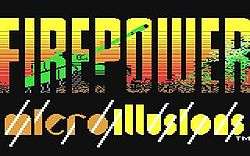Fire Power (video game)
| Fire Power | |
|---|---|
|
Title screen | |
| Developer(s) | Silent Software, Inc. |
| Publisher(s) | MicroIllusions |
| Designer(s) | Baron R. K. Von Wolfsheild |
| Platform(s) | Amiga, Apple IIGS, DOS, Commodore 64, WebTV |
| Release date(s) | 1987, 1988 |
| Genre(s) | Action |
| Mode(s) | Single or multi-player |
Fire Power (sometimes Firepower) is a strategic military tank action game developed by Silent Software, Inc. originally for the Amiga. It was released in 1987 and published by MicroIllusions and Activision. Ports were made for the DOS, Apple IIGS and Commodore 64 [1]systems in 1988.
Summary
The gameplay consists of controlling a tank through an expansive, outdoor landscape. Each map has at least two bases - one for green team, and one for the yellow (red in the PC version) team. Initially, the base locations were hidden from the players, so an extensive search of the landscape had to be conducted first. Nonetheless, many players chose to rampage around the map, simply blasting away. Obstacles included enemy turrets spread around the map, various fortifications and destructible buildings. If the player stood still for too long (to set up an ambush, for instance), a series of enemy helicopters would appear from off screen and attack. The helicopters could be shot down with the tank's main weapon.
A devious strategy (though less effective in split-screen play) was to sneak into the enemy's base, leaving as many of their buildings untouched as possible. By sitting still and pressing the fire button, you could drop land mines which were difficult for the enemy to detect. The player would then drop plenty of land mines around assorted choke points as well as right in front of the enemy garage. Eventually, the enemy would return from rampaging through your base, usually carrying the flag and a full load of POWs. Noticing no damage to his own base (and most likely fooled into thinking that his base was still undiscovered), the enemy would accidentally plow through the fields of land mines and detonate himself (usually at full speed), losing the flag and killing the POWs.
Bases and tanks
Each base had several different types of buildings, such as armories, barracks, and bio-domes. The objective is to capture the flag from inside the enemy base by blasting through walls and destroying any defenses. You could also rescue prisoners of war by destroying the POW camps that were scattered throughout the enemy base. Destroying the camps would allow the captives to hop in your tank for a ride back to your base. An extra tank life was rewarded for each fifteen POWs rescued.[2]
Three different tanks were available - one was fast and fragile, one was slow but powerful, and the third was rated in between the two. Each tank could carry a different amount of POWs. You could swap tanks at any time by re-entering your garage at your home base. To capture the enemy flag, you had to carefully maneuver your tank into the flag building and wait for the flag to be transferred onto your vehicle. Your weapons could not destroy the building that housed the flag or the tank garages.
Features
One groundbreaking feature was the ability to run over enemy soldiers, crushing then with an accompanying "squish" sound effect and a bloody "splat" that remained on the battlefield for several minutes. A map editor was available which allowed the player to create custom multiplayer experiences.
This game can be played alone, against a human opponent on a split screen, or even over a modem, which featured an innovative ability both to play the game in real-time, and allow players to chat simultaneously.
Sequels and unreleased versions
Fire Power spawned two sequels, Return Fire and Return Fire 2.
Unreleased versions were made for the Mac classic (Black vs. White), and WebTV.
References
- ↑ http://pctimeline.info/c64/c641988.htm
- ↑ Screenshot at MobyGames.com showing pre-game instructions: "Lives: Each game starts with five tank lives. One additional life is added each time fifteen men are rescued (unloaded at a friendly first-aid station.)"
